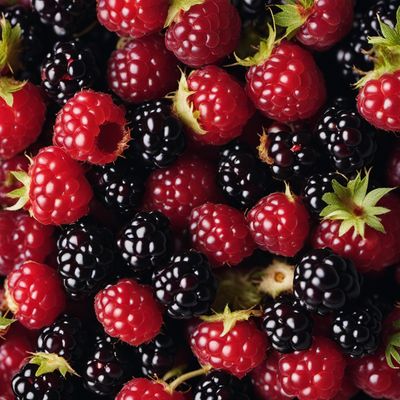
Ingredient
Other cane fruits
The Sweet Symphony of Lesser-Known Cane Fruits
Other cane fruits encompass a variety of fruits that belong to the same botanical family as raspberries and blackberries. These fruits, including loganberries, boysenberries, and tayberries, are characterized by their juicy, sweet-tart flavor and vibrant colors. They have a similar appearance to raspberries, with small, round drupelets that form a cluster. The texture of these fruits is soft and delicate, with a slight crunch from the tiny seeds. Their vibrant hues range from deep red to purple, adding visual appeal to any dish. These lesser-known cane fruits are a delightful addition to both sweet and savory recipes, offering a burst of tangy sweetness that complements a wide range of flavors.
Origins and history
Other cane fruits have a rich history that traces back to the 19th century. The loganberry, a cross between a raspberry and a blackberry, was first cultivated in California by horticulturist James Harvey Logan. Similarly, the boysenberry, a hybrid of blackberry, raspberry, and loganberry, was developed by Rudolph Boysen in the early 20th century. These fruits gained popularity for their unique flavors and versatility in culinary applications. Today, other cane fruits are cultivated in various regions around the world, including North America, Europe, and Australia.
Nutritional information
Other cane fruits are a rich source of vitamins, minerals, and antioxidants. They are low in calories and high in dietary fiber, making them a healthy addition to any diet.
How to select
When selecting other cane fruits, look for plump, firm berries that are brightly colored and free from mold or bruises. Avoid berries that are overly soft or have a dull appearance, as they may be overripe or of lower quality.
Storage recommendations
To maintain the freshness and quality of other cane fruits, store them in the refrigerator in a breathable container or loosely covered with a paper towel. They are best consumed within a few days of purchase but can be frozen for longer-term storage.
How to produce
Other cane fruits can be grown in home gardens or small-scale farms. They require well-drained soil, ample sunlight, and regular watering. Planting cane fruit bushes or vines in early spring or fall will allow them to establish before the growing season.
Preparation tips
Other cane fruits can be enjoyed fresh, added to fruit salads, or used in a variety of culinary creations. They are perfect for making jams, jellies, pies, and sauces. To prepare them, gently rinse the berries under cold water and pat them dry. Remove any stems or leaves before incorporating them into your desired recipe.
Substitutions
If other cane fruits are not available, raspberries or blackberries can be used as suitable substitutes due to their similar flavor profiles and culinary applications.
Culinary uses
Other cane fruits are versatile and can be used in both sweet and savory dishes. They are commonly used in desserts such as pies, tarts, crumbles, and ice creams. These fruits also pair well with savory ingredients like goat cheese, balsamic vinegar, and grilled meats, adding a touch of sweetness and acidity to balance the flavors.
Availability
Other cane fruits are commonly available in regions with suitable climates for their cultivation, including North America, Europe, and Australia.


